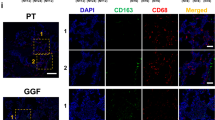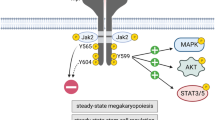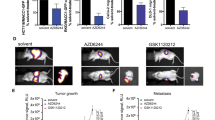Abstract
Previous studies in cell lines have shown Lyn kinase to be a negative regulator of thrombopoietin (TPO)-induced proliferation. To further investigate the role of Lyn during megakaryocytopoiesis, Lyn-deficient mice (lyn−/−) were analyzed. We observed that lyn−/− mice have more bone marrow-derived GPIIB (CD41) and Mpl+ cells when compared to their wild-type littermates. In addition, colony-forming unit-megakaryocytes (CFU-MK) are increased and TPO-induced expansion of primary marrow cells yielded a greater number of mature megakaryocytes (MKs) with increased nuclear ploidy. Histopathology of bone marrow and spleens from lyn−/− mice showed an increase in the number of MKs. Mechanistic studies revealed that TPO stimulation of MKs from lyn−/− mice did not affect phosphorylation of Janus kinase 2 (JAK2), signal transducer and activator of transcription (STAT) 3, STAT5, or MAP kinase kinase (MEK). Lyn-deficient MKs supported greater TPO-mediated phosphorylation and kinase activity of both Erk1/2 (mitogen-activated protein kinase, MAPK) and Akt. In contrast, there was a reduction of tyrosine phosphorylation of the inositol phosphatase, SHIP. This is the first direct evidence using primary MKs from Lyn-deficient mice that confirms our prior data from cell lines that Lyn kinase is a negative regulator of TPO signaling.
This is a preview of subscription content, access via your institution
Access options
Subscribe to this journal
Receive 50 print issues and online access
$259.00 per year
only $5.18 per issue
Buy this article
- Purchase on SpringerLink
- Instant access to full article PDF
Prices may be subject to local taxes which are calculated during checkout








Similar content being viewed by others
References
Anderson SM, Jorgensen B . (1995). J Immunol 155: 1660–1670.
Baran CP, Tridandapani S, Helgason CD, Humphries RK, Krystal G, Marsh CB . (2003). J Biol Chem 278: 38628–38636.
Beavitt SJ, Harder KW, Kemp JM, Jones J, Quilici C, Casagranda F et al. (2005). J Immunol 175: 1867–1875.
Chan VW, Lowell CA, DeFranco AL . (1998). Curr Biol 8: 545–553.
Chan VW, Meng F, Soriano P, DeFranco AL, Lowell CA . (1997). Immunity 7: 69–81.
Cheng JJ, Wung BS, Chao YJ, Wang DL . (2001). J Biol Chem 276: 31368–31375.
Corey SJ, Anderson SM . (1999). Blood 93: 1–14.
Corey SJ, Burkhardt AL, Bolen JB, Geahlen RL, Tkatch LS, Tweardy DJ . (1994). Proc Natl Acad Sci USA 91: 4683–4687.
Cornall RJ, Cyster JG, Hibbs ML, Dunn AR, Otipoby KL, Clark EA et al. (1998). Immunity 8: 497–508.
Drachman JG, Griffin JD, Kaushansky K . (1995). J Biol Chem 270: 4979–4982.
Drachman JG, Kaushansky K . (1997). Proc Natl Acad Sci USA 94: 2350–2355.
Drachman JG, Millett KM, Kaushansky K . (1999). J Biol Chem 274: 13480–13484.
Drachman JG, Sabath DF, Fox NE, Kaushansky K . (1997). Blood 89: 483–492.
Erpel T, Courtneidge SA . (1995). Curr Opin Cell Biol 7: 176–182.
Ezumi Y, Uchiyama T, Takayama H . (1998). Eur J Biochem 258: 976–985.
Filippi MD, Porteu F, Pesteur FL, Schiavon V, Millot GA, Vainchenker W et al. (2002). Blood 99: 1174–1182.
Freeburn RW, Wright KL, Burgess SJ, Astoul E, Cantrell DA, Ward SG . (2002). J Immunol 169: 5441–5450.
Fresno Vara JA, Caceres MA, Silva A, Martin-Perez J . (2001). Mol Biol Cell 12: 2171–2183.
Gardai S, Whitlock BB, Helgason C, Ambruso D, Fadok V, Bratton D et al. (2002). J Biol Chem 277: 5236–5246.
Gauld SB, Cambier JC . (2004). Oncogene 23: 8001–8006.
Geddis AE, Fox NE, Kaushansky K . (2001). J Biol Chem 276: 34473–34479.
Geddis AE, Linden HM, Kaushansky K . (2002). Cytokine Growth Factor Rev 13: 61–73.
Hallek M, Neumann C, Schaffer M, Danhauser-Riedl S, von Bubnoff N, de Vos G et al. (1997). Exp Hematol 25: 1367–1377.
Harder KW, Parsons LM, Armes J, Evans N, Kountouri N, Clark R et al. (2001). Immunity 15: 603–615.
Hernandez-Hansen V, Mackay GA, Lowell CA, Wilson BS, Oliver JM . (2004a). J Leukoc Biol 75: 143–151.
Hernandez-Hansen V, Smith AJ, Surviladze Z, Chigaev A, Mazel T, Kalesnikoff J et al. (2004b). J Immunol 173: 100–112.
Hibbs ML, Harder KW, Armes J, Kountouri N, Quilici C, Casagranda F et al. (2002). J Exp Med 196: 1593–1604.
Hibbs ML, Tarlinton DM, Armes J, Grail D, Hodgson G, Maglitto R et al. (1995). Cell 83: 301–311.
Horn S, Endl E, Fehse B, Weck MM, Mayr GW, Jucker M . (2004). Leukemia 18: 1839–1849.
Kamata T, Pritchard CA, Leavitt AD . (2004). Blood 103: 2568–2570.
Kitaura J, Asai K, Maeda-Yamamoto M, Kawakami Y, Kikkawa U, Kawakami T . (2000). J Exp Med 192: 729–740.
Lannutti BJ, Blake N, Gandhi MJ, Reems JA, Drachman JG . (2005). Blood 105: 3875–3878.
Lannutti BJ, Drachman JG . (2004). Blood 103: 3736–3743.
Lannutti BJ, Shim MH, Blake N, Reems JA, Drachman JG . (2003). Exp Hematol 31: 1268–1274.
Maxwell MJ, Yuan Y, Anderson KE, Hibbs ML, Salem HH, Jackson SP . (2004). J Biol Chem 279: 32196–32204.
Miyakawa Y, Rojnuckarin P, Habib T, Kaushansky K . (2001). J Biol Chem 276: 2494–2502.
Nishizumi H, Taniuchi I, Yamanashi Y, Kitamura D, Ilic D, Mori S et al. (1995). Immunity 3: 549–560.
Nishizumi H, Yamamoto T . (1997). J Immunol 158: 2350–2355.
Pereira S, Lowell C . (2003). J Immunol 171: 1319–1327.
Racke FK, Lewandowska K, Goueli S, Goldfarb AN . (1997). J Biol Chem 272: 23366–23370.
Rojnuckarin P, Drachman JG, Kaushansky K . (1999). Blood 94: 1273–1282.
Rojnuckarin P, Miyakawa Y, Fox NE, Deou J, Daum G, Kaushansky K . (2001). J Biol Chem 276: 41014–41022.
Rouyez MC, Boucheron C, Gisselbrecht S, Dusanter-Fourt I, Porteu F . (1997). Mol Cell Biol 17: 4991–5000.
Santini V, Scappini B, Grossi A, Gozzini A, Bonsi L, Pagliai G et al. (2002). Haematologica 87: 1242–1247.
Schwartzberg PL . (1998). Oncogene 17: 1463–1468.
Smith KG, Tarlinton DM, Doody GM, Hibbs ML, Fearon DT . (1998). J Exp Med 187: 807–811.
Stafford S, Lowell C, Sur S, Alam R . (2002). J Immunol 168: 1978–1983.
Thomas SM, Brugge JS . (1997). Annu Rev Cell Dev Biol 13: 513–609.
Tilbrook PA, Ingley E, Williams JH, Hibbs ML, Klinken SP . (1997). EMBO J 16: 1610–1619.
Wang J, Koizumi T, Watanabe T . (1996). J Exp Med 184: 831–838.
Acknowledgements
We thank those individuals who have contributed to this manuscript: Janet Oliver (University of New Mexico) for lyn−/− mice; Jan Johnson (University of Washington) for advice and discussions; Amgen and Zymogenetics for originally providing anti-Mpl antiserum. This work is supported by the National Institutes of Health Grants K01DK065129 and R01HL65498.
Author information
Authors and Affiliations
Corresponding author
Rights and permissions
About this article
Cite this article
Lannutti, B., Minear, J., Blake, N. et al. Increased megakaryocytopoiesis in Lyn-deficient mice. Oncogene 25, 3316–3324 (2006). https://doi.org/10.1038/sj.onc.1209351
Received:
Revised:
Accepted:
Published:
Issue date:
DOI: https://doi.org/10.1038/sj.onc.1209351
Keywords
This article is cited by
-
C3G contributes to platelet activation and aggregation by regulating major signaling pathways
Signal Transduction and Targeted Therapy (2020)
-
PSTPIP2 dysregulation contributes to aberrant terminal differentiation in GATA-1-deficient megakaryocytes by activating LYN
Cell Death & Disease (2014)
-
Cholesterol efflux in megakaryocyte progenitors suppresses platelet production and thrombocytosis
Nature Medicine (2013)
-
Inhibition of imatinib-mediated apoptosis by the caspase-cleaved form of the tyrosine kinase Lyn in chronic myelogenous leukemia cells
Leukemia (2009)
-
The α1-adrenergic receptor antagonists, benoxathian and prazosin, induce apoptosis and a switch towards megakaryocytic differentiation in human erythroleukemia cells
Annals of Hematology (2009)



